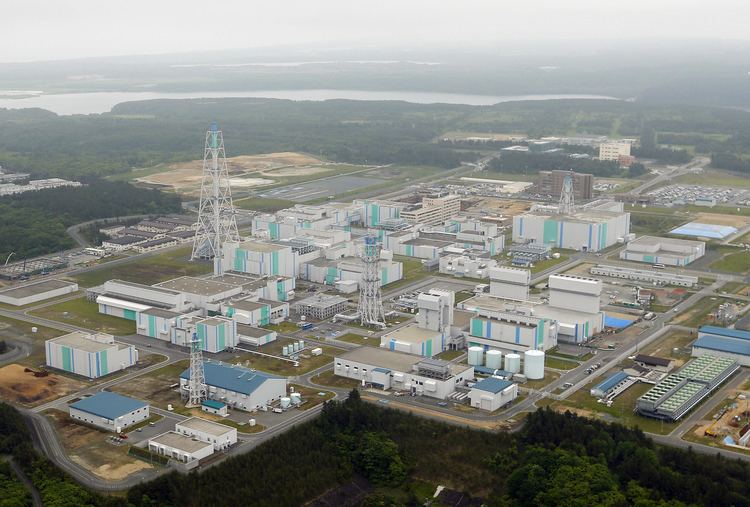Country Japan District Kamikita - Flower Daylily Population 10,549 (1 Feb 2017) Bird White-tailed eagle | Region Tōhoku - Tree Japanese black pine Area 253.7 km² Local time Wednesday 12:18 AM Prefecture Aomori Prefecture | |
 | ||
Time zone Japan Standard Time (UTC+9) Weather 3°C, Wind W at 21 km/h, 89% Humidity | ||
Rokkasho (六ヶ所村, Rokkasho-mura) is a village in Kamikita District of northeastern Aomori Prefecture in the Tōhoku region of northern Japan. As of 1 February 2017, the village had an estimated population of 10,549 and a population density of 41.5 persons per km², in 4,953 households. The total area of the village was 252.68 square kilometres (97.56 sq mi).
Contents
- Map of Rokkasho Kamikita District Aomori Prefecture Japan
- Geography
- Neighbouring municipalities
- Demographics
- History
- Economy
- Nuclear industry Research
- Gas and wind power
- Agriculture
- Fishing
- Education
- Railway
- Highway
- International relations
- Local attractions
- In popular media
- References
Map of Rokkasho, Kamikita District, Aomori Prefecture, Japan
Geography
Rokkasho occupies the eastern coastline of the base of Shimokita Peninsula, facing the Pacific Ocean to the east. The village has a cold maritime climate characterized by cool short summers and long cold winters with heavy snowfall (Köppen climate classification Cfa). The average annual temperature in Rokkasho is 9.6 °C. The average annual rainfall is 1213 mm with September as the wettest month.The temperatures are highest on average in August, at around 22.4 °C, and lowest in January, at around -2.0 °C. The village forms the northern shoreline of Lake Ogawara.
Neighbouring municipalities
Demographics
Per Japanese census data, the population of Rokkasho has remained relatively stable over the past 40 years.
History
The area around Rokkasho was known for raising horses during the Kamakura period. During the Edo period, it was controlled by the Nambu clan of Morioka Domain, becoming part of the territories of Shichinohe Domain in the latter half of the Edo period. With the establishment of the municipalities system after the start of the Meiji period, on April 1, 1889, Rokkasho Village was proclaimed from the merger of six small hamlets.
Economy
The economy of Rokkasho has traditionally been dependent on agriculture and commercial fishing. From the 1980s onwards, the village has become a center for various energy developments, which now dominate the local economy.
Nuclear industry & Research
Nuclear fuel cycle related facilities:
The Japan Atomic Energy Agency also has multiple facilities at the site like the Linear IFMIF Prototype Accelerator (LIPAc) devoted to the Fusion Energy Development Programme under the European Union-Japan Broader Approach agreement.
Since the 1970s local opposition to plans to operate Japan's first large commercial plutonium plant at Rokkasho have focused on the threat of a large-scale release of radioactivity. During the 1990s anti-nuclear groups in Japan released studies showing the risks of routine operation of the Rokkasho Reprocessing Plant. The facility in full operation is designed to separate as much as 8 tons of plutonium each year from spent reactor fuel from Japan's domestic nuclear reactors. As of 2006 Japan owned approximately 45 tons of separated plutonium.
In May, 2006 an international awareness campaign about the dangers of the Rokkasho reprocessing plant, Stop Rokkasho, was launched by musician Ryuichi Sakamoto. Greenpeace has opposed operation of the Rokkasho Reprocessing Plant under a campaign called "Wings of Peace: No more Hiroshima, Nagasaki. Stop Rokkasho", since 2002 and has launched a cyberaction to stop the project.
Rokkasho was a candidate to host the plasma fusion reactor ITER, but lost out to Cadarache, France. Rokkasho has been hosting high-performance supercomputer centre capable of performing complex plasma physics calculations for fusion research, since January 2012.
Gas and wind power
Agriculture
Stock raising is prevalent.
Fishing
Three small fishing ports.
Education
Rokkasho has four public elementary schools and four public middle schools operated by the village government and one public high school operated by the Aomori Prefectural Board of Education.
Railway
Highway
International relations
Waren, Mecklenburg-Vorpommern, Germany Sister city since 1994.
Local attractions
In popular media
A documentary, Rokkasho Rhapsody, came out in 2006, which portrays the Rokkasho community's views on the nuclear reprocessing plant.
